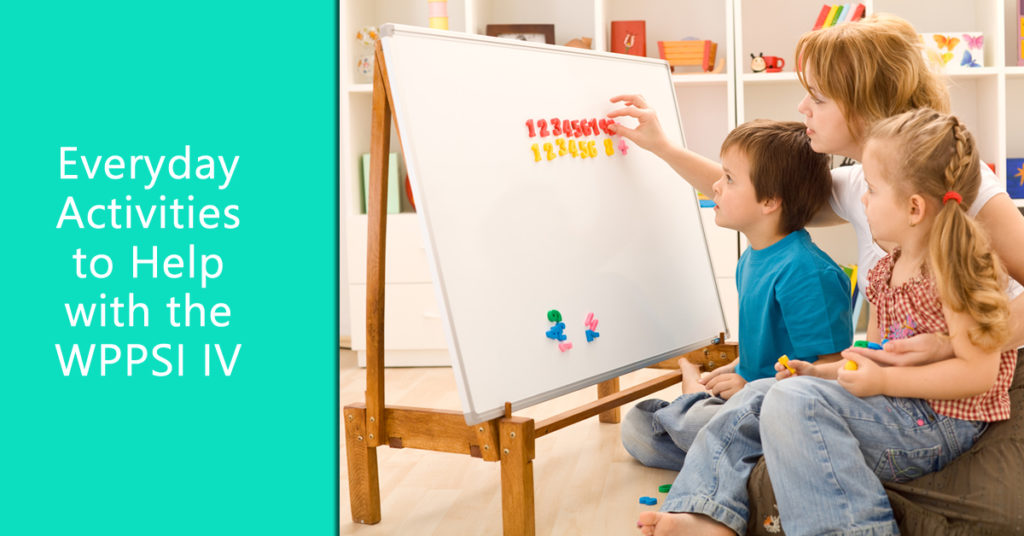› Everyday Activities that Help with the WPPSI™ IV Subtests: Verbal Section
Everyday Activities that Help with the WPPSI™ IV Subtests: Verbal Section
posted by Karen Quinn, The Testing Mom - August 23rd, 2017
The WPPSI™ IV Test is broken into subtests, which help to easily identify what your child knows and understands, as well areas that could use improvement. As your child progresses through each subtest, the questions will gradually get more difficult; when your child misses a certain amount of questions in a row, the examiner will then move on to the next subtest.

Today I want to focus our everyday activities on the VERBAL subtests. These subtests are specifically chosen and broken into younger and older age groups, so that the test is age appropriate, fun and engaging for each child.
What’s on the WPPSI IV Subtests anyway?
Your child will take either 3 or 6 subtests when taking the WPPSI-IV, depending on how old he is. These are outlined below. (The ages are years, then months, so 2:6 means 2 and a half years old.)
VERBAL COMPREHENSION Ages 2:6 – 3:11
Receptive Vocabulary measures your child’s ability to identify correct responses to spoken words. A word is spoken and the child chooses the picture that describes the word.
Information measures your child’s general knowledge of culture, long-term memory, and acquired facts. Again a word is spoken and the child points to the picture.
Picture Naming assesses your child’s ability to understand essential and nonessential parts from the whole from a picture. Your child will name or indicate the missing part by saying the name of the part or by pointing to it.
VERBAL COMPREHENSION Ages 4:0 – 7:7
Receptive Vocabulary measures your child’s ability to identify correct responses to spoken words. A word is spoken and the child chooses the picture that describes the word.
Information measures your child’s general knowledge of culture, long-term memory, and acquired facts. Again a word is spoken and the child points to the picture.
Picture Naming assesses your child’s ability to understand essential and nonessential parts from the whole from a picture. Your child will name or indicate the missing part by saying its name or by pointing to it.
Similarities measures your child’s logical thinking, verbal concept formation, and verbal abstract reasoning. A child is shown two similar, but different items and is asked to tell how they are alike or different.
Vocabulary measures the your child’s verbal fluency, concept formation, word knowledge, and word usage. A child is given a word or concept and given a score based on the accuracy or specificity of their answer.
Comprehension measures your child’s ability to answer questions about social standards of behavior, cultural, or other concepts they should know by the time they are assessed.
Everyday Activities that Help Your Child with the WPPSI IV
- Read concept books such as Richard Scarry’s Best First Book Ever (This book has EVERYTHING a child needs to know for kindergarten!) or DK Publishing’s My First Word Book to your child. Children tested for kindergarten are expected to know colors, shapes, seasons, fruit, farm animals – all the basic information kids are exposed to through picture books, preschool, and life itself. If your child knows everything covered in these books, she’ll be ready.
- Expose your child to the wonderful world of riddles. Learning age-appropriate riddles can be a fun, interesting way to expand your child’s vocabulary, reading comprehension, problem-solving and critical thinking skills. Another surprising benefit? Laughter causes the brain to release dopamine and the pituitary gland to release endorphins, both of which ease stress and promote relaxation. (Which means you’ll be less stressed out about your kid taking the test, too!)
- Read books aloud to solidify knowledge and comprehension. Knowledge and comprehension are your child’s understanding of information, social standards of behavior, and common sense that children his age usually understand.
- Take your child with you when running errands! Nothing beats real experiences like going to the doctor, visiting a beach, baking cookies, or taking a trip to the grocery store for acquiring knowledge. Then, later on, find read-alouds on those subjects and say, “Remember when…?”
- Point out similarities and differences everywhere you go. Try asking questions like, “How is the microwave like our oven?” when you’re cooking dinner (both heat up food/drinks and are found in the kitchen) or “What makes an orange different from a peach? How are they alike?” (both are fruits that are orange in color, but peaches have fuzzy skin you can eat and one large, inedible pit in the center; oranges have seeds/can also be seedless and must be peeled first, then pulled apart into segments before eating). Soon, your child will be doing this exercise naturally and without any prompting!
- Hands On Learning gives you a great starting point with concepts like weather, time, parts of the body and senses!
The key is to be engaged with your child. Talk about everything! Ask questions to gauge your child’s understanding. Then let there be quiet spaces, where you let her figure it out without giving the answer–time and margin are great training tools. Also? You can turn everyday activities into learning opportunities!
Finally check out our other resources on our WPPSI™ IV Test pages:



Tell us about your experiences